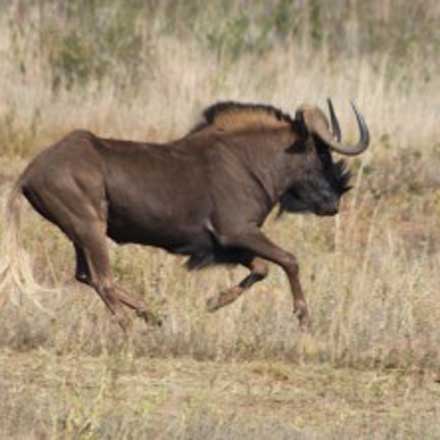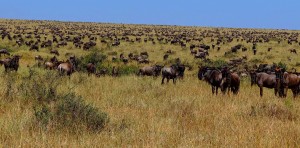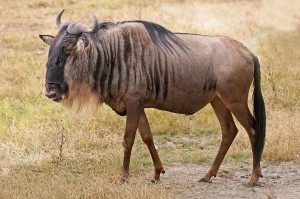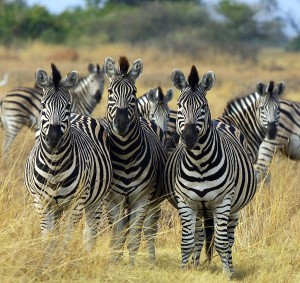
At a large shooting trade show in 2000, I was able to see and handle the new .376 Steyr ProHunter rifle, for the very first time. Sporting a handy 20” barrel, and great adjustable sights, the ergonomics of the rifle appealed to me right away. The synthetic stock had a palm swell in the pistol grip, and a natural channel in the forend, for the fingers of your left hand. The bolt had a full-diameter body, and cycled extremely smooth. The trigger I found to be outstanding, not a typical “lawyer influenced” heavy pull at all. The length of pull was adjustable, by adding or removing 3/8” spacers. Also, the sling swivels were a flush mount, quick release type, so when shooting from the bench, no studs projected to hang or tear up shooting bags. The new .376 Steyr cartridge used .375 caliber bullets, was a non-belted case, larger than the .35 Whelen, but smaller in capacity than the much longer .375 H&H. In fact, its ballistics came to within 150 fps of the classic H&H, on a shorter, lighter platform. Out to 250 yards or so, I doubted that medium to heavy game would react any differently, if proper bullets were selected for animal’s size.
I purchased one as soon as I got home, and proceeded to begin load development. Six months, and 1,100 rounds later, I was pleased to have developed over a dozen sub-MOA loads, using that many different bullets, running from 200 to 300 grains. Some of the best loads consistently shot under one-half inch, for 3-shots at 100 yards! 210’s could reach 2,900; 225’s did 2,800; almost 2,700 with 235’s; 2,500 was no problem with 270’s; and 300’s could even reach 2,400 fps. I also found that much milder loads with the lighter weight to be very accurate, and would be useful for deer, black bear or hogs, offering plenty of power with modest recoil. When my Zimbabwean friend Stephan called me in 2001, I knew for certain that my .376 would go with me to hunt in Africa. All told, seven head of game were taken- eland, zebra and wildebeest- using my .376 ProHunter, with very impressive results.
Chapter 1: .376 Meets Plains Game
Unusually, Hornady offered two different weight factory loads, both loaded to 2,500 fps. The first was a lighter 225 soft point for deer, black bear, or hogs, offering less recoil than the second, a heavier full-power 270 grain for medium to large game. While almost all cartridges offer light and heavy bullets, they typically are all...
loaded to maximum speeds. A nice feature with the .376 Steyr, is that the lighter load delivers plenty of bullet weight for most North American game, at a manageable recoil level.

For my safari, I brought along some of the 225 factory loads to try on medium sized plains game, as well as the 270 factory load, and some Barnes 270 X-Bullets loaded by me to 2,500, for larger animals. The Barnes consistently shot under one-half inch for 3-shots, at 100 yards, using Ramshot TAC powder! I also brought along a few handloads using the 300 grain Swift A-Frame, loaded to just under 2,400 fps.
Chapter 2: Safari Camp Life
I was hunting a large farm, near Darwendale, about an hour due west of Harare. I had my own private chalet to stay in, about 20’ wide by 30’ long, with a four-foot high natural stone wall all around, and having a foot thick, steep-pitched, thatched grass roof for cover. Curtains covered both open ends of the chalet at night, but they would be pulled fully back during the day, offering splendid views to the north or south. Two double beds were in the great room, with a large table, chairs and a couch. The bathroom had a natural stone shower with heated water, and a flushing toilet. In the morning, I could leave my dirty clothes on my bed, and when we returned in the early evening, they would be lying pressed and neatly folded on my made bed- shirt, shorts, underwear and socks. Great service like that, is not too hard to take at all!
The camp had a beautiful in-ground pool, which incorporated some of the HUGE granite boulders that abounded on the property. Some of the monoliths were the size of a couch, some bigger than a car. Rather than move them, they were incorporated into the structure, be it a pool, or even the kitchen. Just as one large granite rock was a part of the pool wall, a massive rock was in a perfect place where the kitchen hall was built around it. Rather than fight nature, a concrete work top was simply poured on top of it, and polished smooth. This is where all the prepared food was placed, before being brought out to the dinning chalet.
Normally, returning from the field...
after a long day of hunting, hunters would clean up a bit, and then go sit at the open bar around the fire pit, to have a few drinks, and tell stories. While this was occurring, a fantastic meal was being prepared for all, to be served in the beautiful dinning chalet, on fine china, wine being served in nice crystal glasses. I always chose instead, to first head to the butchery, a small stone building with a high ceiling, for hanging the game. This is also where game taken in the morning or afternoon, would be dressed for the first time.
That’s why none of the game was ever field dressed.
Yes, if you took a zebra at 9 am, it was not field dressed right away, like we would in the US. Especially considering that it may be in the 80s, 90s, or even hotter, all game taken would be placed “as is” in the back of the Land Cruiser, where it lay untouched until the early evening. By then, everything you shot during the day, would be so bloated, it would rock and roll around on its back, in the rear of the vehicle. Why did they wait so long to dress the game?
Because EVERYTHING was saved from every animal- nothing went to waste. The PH would sell the dressed carcasses to a butcher, to be cut up and sold as meat, bringing him in a little extra cash. The trackers would do all of the dressing in the butchery, and they got to keep all the organs and entrails- this was pretty much the only time they ever got to eat meat.
That’s why none of the game was ever field dressed. They waited until the end of the day, to be able to keep all the insides clean, until the game could be brought and hung in the butchery. There, it was dressed, where clean water could be used to rinse everything off. The trackers could then divide up all the internals, ensuring every family got a share. On this farm a small village existed, constructed by the landowner, as a place where his workers and the hunting trackers, could live as part of their compensation.
Chapter 3: Factory Load Wildebeest
Having had a great first afternoon with my .308 Scout, leaving for a full day of hunting on day two, I chose to instead grab my camo .376 Steyr from my hut, just before we loaded into the Land Cruiser. Hoping to get a wildebeest, I filled the magazine with 225 grain Hornady factory loads. They produced right at 2,500 fps, and shot into just over an inch...
and a quarter, when sighted 2 inches high at 100 yards. The load was pretty much on at 200, and just a little low at 250. Producing recoil similar to a 220 grain in the .30-06, most every hunter could shoot it fairly comfortably.
Nearly a dozen types of game were available, and in seven day of hunting, I was able to collect eight different species of plains game, and several other smaller animals. How about being offered the chance to take wildebeest, zebra, warthog, impala, ostrich, eland, tsessebe, blesbok, jackal, hyena, or even giraffe? Most any time of the day, I could look out and see dozens and dozens of head of game, grazing peacefully on the grassy plains.
In fact, it very much reminded me of the scene in Jurassic Park, when they first looked up and saw all of the dinosaurs spread before them. I actually kept playing the theme music from the movie, over and over in my head, each time I looked out and was greeted by all of the African plains game. In situations like this, only your checkbook, or the cash you have on hand, was the limiting factor of what you could harvest. Altogether, I collected 28 animals in that week of hunting, paying local rates, for only around $7,000 US, which included my daily rate. But towards the end, on a phone call to my brother, I actually did admit, to getting a little tired of hunting…
“Tired of hunting?” you may ask!?!?!
Well, it’s one thing to go out by yourself, or with a few friends near your home. Or possibly even travel a bit out of state, where you still may hunt mostly by yourself. You
might spend several days, a week or even longer, and perhaps never even see any game, much less a shootable large buck or bull elk. You may eventually get a chance at a nice animal, but if by yourself, should you make a great shot, a bad one, or even miss an easy shot due to buck fever… no one may be around to see any of this. Not too much pressure in a situation like that.
But in Africa, at least where I was hunting, think of it more like a buffet, only three or more people are there to stand and watch, every good and bad thing you do. At the minimum, every time I lined up and took a shot, there were at least two trackers and my PH watching me, sometime even more people. Make a tough shot, and you feel wonderful, as person after person will congratulate you and tell you what a great shot you are, and such a cool headed marksman to make a that shot. ...
Think how you feel though, when that entire group of people sees you miss an easy shot on a trophy, that even a beginner would’ve had no trouble making?

Worse yet, make a poor shot that doesn’t drop the animal… and have to deal with the emotions of those people working for hours or days, tracking the potential record book animal they all saw you wound. I know you don’t feel sorry for me at all, but just so you know, you will feel these shooting pressures, whether you take three animals… or almost three dozen.
Around mid-morning, I had my first chance on game with my .376. Lining up on a wildebeest bull, at a paced 136 steps, he was hit quartering away near the back ribs, hoping to angle forward to the opposite shoulder, with a 225 Hornady. A short bucking dance, and within 25 yards the first animal taken was down and out. Walking up to the bull, the bullet had hit the second from the last rear rib, and when we rolled him over, saw a bulge under the hide, on his far shoulder. The bullet had diagonaled thru his chest about two feet, and broken through the far shoulder blade, stopping just under the hide.
A small cut with my knife, and out popped the nicely expanded Hornady. Later at home, I measured it to have doubled in diameter, and still weighing 196 of the original 225 grains- perfect performance in my opinion. Based on this, it would be great for kudu, and possibly even zebra, for broadside shots. In the US, it would be a great load for deer, black bear, hogs or even elk, with considerations of course, for range and position of the game.
Chapter 4: Heavy Bullets, Heavier Game
My first zebra was taken with a 270 Hornady factory load, at just under 200 yards. Struck mid-chest, broadside, just behind his left leg, he dashed perhaps 40 yards… before tumbling over in a cloud of dust. My PH Paul was very pleased with this performance, as were both trackers. Normally they say, zebra can go for quite a ways, even after a good hit. More and more, the .376 Steyr is really growing on me. It carries and handles great in the field, and I’m shooting it like an accurate .308; game shows signs of being hit...
hard, and aren’t capable of traveling very far after a good hit.
Now it’s time for bigger game, so I load my magazine with the 270 Barnes X-Bullets. With TAC powder, I’m getting an honest 2,500 fps from the handy 20-inch barrel, and it regularly puts three of these deep-driving copper bullets into under a half-inch at 100 yards. I feel like a sniper, with that load in my ProHunter. The first larger game with this gun and load, was a management eland, running around 800 lbs. Quartering away at about 80 yards, I aim for the very last rib on the right side, and at the shot, the bullet passes completely through. Turn out, it broke the left shoulder blade on its way out, whistling off to who knows where? Paul is really impressed by that- and wonders what it would take to stop one of these bullets from the Steyr? Soon, we’ll be finding out. Zebra time has come.
In very heavy brush, we came upon a small heard of six or so zebra, at only around 40 yards distant. I place a 270 Barnes broadside into a stallion, while his head is down feeding. He buckles at the shot, and dashes off into very heavy cover, consisting of broad leafed bushes. I take off running after him, and in no time at all, find him standing. Facing almost directly away from me, his head is held low, and looking like he’s ready to drop. He’s barely 20 paces from me.
In the US, hunters like to make one shot, and then stand around to admire it, hoping the game will soon go down. In Africa, they want you to keep shooting, until the critter is down on the ground. One of the trackers has just come up behind me, and sees my rifle is up, aimed on the zebra. The stallion suddenly senses me, raises his head, and begins to lurch ahead. I fire; aiming at the point of his right hip, visualizing that the Barnes will course forward, hopefully reaching the lungs. He drops at the shot and lay motionless, having never even taken a step. The tracker is screaming and hollering, as am I. Soon, my friend Stephan, the other tracker and PH all arrive, and are happy to see the large stallion lying before us.
The confidence I have in it now, is just incredible.
That evening in the butchery, the trackers find the bullet from my last round; the first broadside shot having exited. Where did they find it? Just inside the front of the zebra’s chest, against the ribs. The Barnes had entered on...
the point of the right hip, traveled down through the intestines, the stomach, liver and diaphragm, through the right lung, passing just over the heart, finally stopping against the inside of the front of his chest. The bullet was perfectly expanded, with full weight retention, after going through over five-feet of a full grown zebra. Everyone in camp is amazed, at what the .376 is capable of, on heavier game with the right bullet. I’m so happy with my choice of a medium caliber weapon, and can hardly wait to take more game with it. The confidence I have in it now, is just incredible.
Later in the week, my third zebra of the hunt is taken using the Barnes 270, with a quartering on shot, at just over 100 yards. Hit on the point of the left shoulder, the bullet diagonals rearward, exiting behind the last rib on the far side. It weakly staggered only about 15 yards, falls over, and lays motionless. The very next day, a fourth stallion was taken with the same load, as he faced me dead on. Oh how I wished, a video camera would have been there, to capture this moment.
Stephan, my PH Pau, the two trackers and I, were driving around mid-morning, when we spotted three zebra off in the distance, feeding in a semi-open area, with plenty of bushes scattered around. We stopped well short of them, parking behind some cover, and proceeded forward, always keeping brush between ourselves and the zebra. We closed the distance considerably, finally getting to just under a 100 yards from the group. The largest male was feeding with his head down, directly facing us in the 12 o’clock- 6 o’clock orientation. Leaning my .376 against a small tree, Paul quietly whistled, causing the stallion to raise his head. At that moment, I aimed at the v-point of his sternum, on the front of his chest, and sent a 270 Barnes on its way.

At the shot, the zebra did a quick quarter turn to our right, causing him to be fully broadside to us. Expecting him to run, we’re all shocked to see the stallion, rear fully up on his hind legs. His head was eight feet or more in the air, with his front legs pawing at the sky, just like you see wild horse do in the movies. He stood like that, pawing for a few seconds, then dropped...
and ran to the right in a tight quarter-circle, falling and lying motionless, not twenty yards from where he was first hit. All of us will never forget the sight of the stallion, rearing up like that, pawing at the sky!
Everyone couldn’t wait to get back to the camp early that evening, heading straight for the butchery, to see how the bullet had performed. The Barnes struck exactly where aimed, at the v-point of the sternum, dead center on the front of his chest. The heart had centered, now having a three-quarter inch hole through it, with extreme trauma also inflicted to the insides of both lungs, as the bullet ranged rearward- but how far would it go?
The Barnes went through the diaphragm and then the liver. We found an entry hole in the front of the huge, grass-filled stomach, and amazingly, the rear, having penetrated through the 30-gallon sized container of wet, chewed grass. No one can believe it made it completely though that! Then we start going through the jumble of intestines. We find a section with an entry hole, then an exit. We keep tracing the path through more and more portions, heading towards the very rear. Finally, a hole into the large colon, but no exit! Opening that with a knife, I traced it rearward, and was amazed to find the expanded 270 Barnes; to be within an inch of exiting the rectum. The bullet had given almost full-length penetration in a large zebra- well over five-feet!
Chapter 5: Fifth and Final Zebra
Having repeatedly seen how well the 270 Barnes works in the .376 Steyr, I wanted to take my next zebra with a few of the 300 grain, Swift A-Frame bonded bullets, I’d also brought along. These were loaded to just under 2,400 fps, and had plenty of power and were of good construction, to do the job. But sometimes things turn out, that are hard to explain, and, even harder to believe.
Another one of my stories, titled “Kudus In The Cotton” covers very well, an amazing thing that happened with a .375 Barnes X-Bullet, during my first hunt back in 1996. Just as this story of my last zebra… will also leave you wondering, as it did everyone in camp. It truly covers the full range of emotions one can experience on a hunt.
But it’s best told as story all on its own, so to read about it, you’ll have to look up, “Bad Day Zebra”, in an upcoming posting and narration…